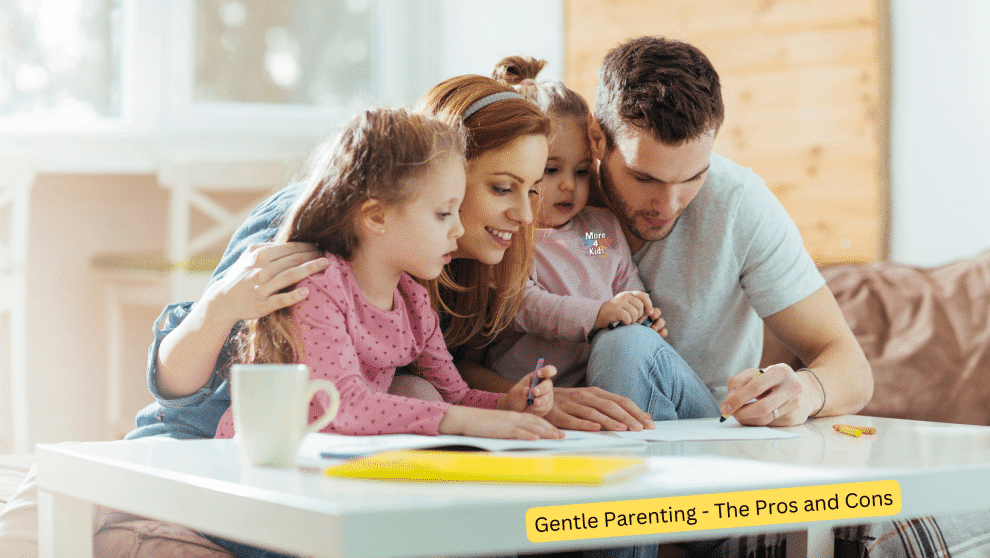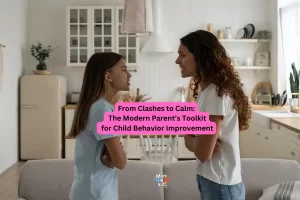While there are many parenting styles, gentle parenting, one of the most popular approaches, sometimes known as attachment parenting, emphasizes building a strong emotional bond between parent and child. This promotes positive communication and understanding. Parenting sometimes feels like a roller coaster with its many ups and downs and every parent wants to raise their children in the best possible way.
The lifelong quest to be an even better parent to your child than your parents were to you requires patience, persistence, cooperation, kindness, and the desire to live your life as a role model to your children. That way your children are likely to develop lovely character traits like kindness, honesty, self-control, independence, and self-direction. So how do you choose what parenting method to follow to get there? Educate yourself.
Gentle parenting is a parenting style that focuses on empathy, connection, and respect between the parent and child. While many parents find this approach to be effective and rewarding, there are also potential drawbacks to consider. In this article, we will discuss what gentle parenting is, the pros and cons of gentle parenting, and some personal examples that I hope you can relate to. My time as a stepmom, bio mom, and foster parent, helping to raise nine children, gave me plenty of experiences to share.
1. What is gentle parenting?
Table of Contents
Gentle parenting is a style of parenting that focuses on building a strong and loving relationship between parent and child. It is a style that prioritizes empathy, kindness, and respect. Gentle parenting involves treating your child as an individual with unique needs, wants, and feelings. It encourages parents to listen to their child, understand their emotions, and respond with compassion.
2. Gentle parenting discipline
Some people mistake gentle parenting for “permissive” parenting. This couldn’t be further from the truth we’ve experienced. Discipline is a crucial part of parenting, and gentle parenting is no exception. Gentle parenting discipline is about teaching your child right from wrong, without resorting to physical punishment, or shaming. It is about setting clear boundaries and expectations and helping your child understand the consequences of their actions.
Gentle parenting discipline involves positive reinforcement, such as praising your child for good behavior, and redirection, such as guiding your child to a more appropriate activity. It also involves natural consequences, such as allowing your child to experience the consequences of their actions. For example, if your child throws a toy, they will not be able to play with it for the rest of the day.
3. Pros of gentle parenting
One of the most significant benefits I found in gentle parenting is that it helps build a strong and loving relationship between parent and child. By prioritizing empathy and connection, parents who practice gentle parenting are more likely to have children who feel heard and understood. This is especially important for children, as I experience with my foster kids, who didn’t have a solid foundation in their original home. The emphasis here establishes the parent’s authority with gentle methods that foster a safe and peaceful home environment.
Avoiding physical and mental injury while being consistent, persistent, and relentless about setting structure around discipline, family time, meals, school, and expectations, allows children to grow into wonderful citizens who want to continue these skills in families of their own.
Another benefit of gentle parenting is that it promotes emotional intelligence. By encouraging children to express their emotions, parents who practice gentle parenting are helping their children develop the emotional skills they need to navigate life’s challenges.
Gentle parenting also promotes better behavior. By using positive reinforcement and natural consequences, parents who practice gentle parenting are teaching their children to make better choices. Instead of punishing their children for misbehavior, they guide them towards better behavior. If a little one is throwing blocks at the wall, for example, provide him with a bucket to aim for instead.
4. Problems (Cons) with gentle parenting
Permissive Parenting Con
While gentle parenting has many benefits, it also has its share of problems. One of the main criticisms of gentle parenting is that it can tend towards permissive behavior. Parents who practice gentle parenting may be hesitant to set boundaries or enforce rules, for fear of hurting their child’s feelings. This can lead to children who are not well-behaved, and who have difficulty adjusting to rules and expectations in other areas of life.
Time Consuming
Another problem with gentle parenting is that it’s time consuming. Gentle parenting requires a lot of time and effort on the part of the parent. It involves listening to your child, understanding their emotions, and responding with compassion. This can be challenging for parents who have busy schedules. Or who are dealing with other stressors. I don’t know any of us that are our “best selves” when we’re exhausted.
My kids always tell me that the easiest example they have for this is when they witness other people “counting” at their children. “I’m going to give you 10 seconds to stop that behavior… 1. 2. 3…” My kids will just look to me and laugh. Their experience if they’re acting “badly,” or in a way I won’t tolerate, they’ll stop immediately with either a look for me or, if that isn’t sufficient, I get up and move towards them, which makes them stop. It is harder when you’re tired, to be sure, but so important. Can you imagine giving children more time to misbehave or continue undesirable behavior ever creating a better-behaved child?
And please, don’t ever threaten the child with a punishment you’re not willing to carry out. Think first. My family spends a lot of time at theme parks. We hear parents threatening their kids regularly.
“I’ll take you back to the hotel if you don’t start behaving.”
Yet I’ve never seen one parent follow through on that threat. They don’t want to miss the opportunity of that roller coaster or that ride. They don’t want to leave the theme park they’ve spent a lot of money to get to.
Consequences
So do yourself a favor and never threaten with something you’re not willing to carry out as a punishment or consequence. Make the consequence immediate so they remember and attach it to the undesirable behavior, make it memorable, but make it commensurate with the offense. If the kids are arguing, make them (gentle) hug each other. If they said something unfortunate or snapped at you, maybe a prayer will work.When my (bio) daughter was four years old, we were at Walt Disney World for the first time and standing in line when she said something I didn’t appreciate.
We were both tired and, truthfully, I should’ve taken us back to the hotel for a nap. But I’d spent a lot of money to get there, and we had a very limited time at the parks, and I didn’t want to miss anything. Her consequence was to say ten Hail Marys. People stared but I persisted. She started with an angry look on her face and a pouty, “Hail Mary full of grace…” in her cute little yellow dress and tiny white strap sandals (I can still picture it today) but by the middle of the second prayer, she was smiling and swinging her arms. Take it as divine intervention if you will, but it rescued the day.
Kids with Emotional and Behavioral Challenges
Another problem with gentle parenting is that it may not be effective for children with behavioral or emotional challenges such as ADHD or oppositional defiant disorder, those that benefit from seeking additional medical intervention. If you suspect this is true for your child, please be sure to speak to your pediatrician and any behavioral health practitioner they recommend.
For some parents, a challenge with gentle parenting is the emphasis on constant availability and responsiveness to your children. If this leads to your own lack of self-care, it can ultimately be detrimental to both parent and child.
Finally, gentle parenting may not be the best approach in a situation where the child’s safety is at risk. In these situations, as I discovered, more assertive and protective parenting may be necessary.
My child was spanked six times in her life, and I remember each time vividly. Each and every time was related to her being young and doing something that risked her own life. Like walking onto a busy highway when her grandmother was supposed to be watching her. I would’ve rather spanked Grandma. Or leaving the house at age 6 when I’d fallen asleep and allowing herself to be lured into a stranger’s house to “see a turtle.” There was no other way at that age to make the point as vigorously as a sharp rap on the rump. But it really did hurt me as much as it hurt her.
5. Gentle parenting books
If you’re interested in learning more about gentle parenting, there are many books available on the topic. You can check them out at your library, on a library app on your phone, or buy them at Amazon or your favorite bookstore. Some of the most popular books include:
“Gentle Measures in the Management and Training of the Young” by Jacob Abbott (available on Libby)
“Parenting with Love and Logic” by Foster Cline and Jim Fay
“No Drama Discipline” by Daniel J Siegel and Tina Payne Bryson
“The Whole Brain Child” By Daniel J. Siegel and Tina Payne Bryson
“The Gentle Parent: Positive, Practical, Effective Discipline by LR Knost
“Peaceful Parent, Happy Kids” by Laura Markham
Examples of gentle parenting from our home and results
When I was a foster mom in Washington state a commercial ran that said, “not everyone can be a foster parent, but everyone can help a foster child.” That’s so true. And it relates to how we discipline all our children, biologic, step, foster, maybe even our grandchildren.
When I was growing up in the 1970s, it wasn’t uncommon for mom to use a wooden spoon to spank us when we misbehaved. Now, people get arrested for spanking their children in public. There’s always been a line between discipline, even when physical, and abuse. Yet with practice, patience, and experience, we can learn how to get our children to behave the way we want and need them to without violence, shame, or any physical or mental distress. That’s my take on gentle parenting.
When foster children entered our home, whether placed urgently by the state, or respite for their own foster families, understanding the rules was critical. One of the most important things, right away, was an all-encompassing hug. They were always warned that it was coming, so it wasn’t a surprise, and yet as soon as I felt the child relaxed in my arms, I knew it would be OK and sense they did as well.
Over a family meal, after the child had unpacked her bag, we’d discuss expectations. Foster care makes it easy to be a “gentle” parent since any form of physical discipline is strictly prohibited.
How Multiple Kids have Helped
Having other children in the home helped tremendously. The bonus child would look to my own child and mirror her behavior. She was raised in a non-violent household before “gentle parenting” became the “in” phrase and helped emulate my parenting style with our new family members. Using words. Avoiding shaming. Being present in the moment and always supportive of the individual while not tolerating inappropriate behavior remains key.
Finally, while gentle parenting can be an effective approach for many families, it is important to carefully consider its potential disadvantages and limitations and to adapt parenting strategies as needed to meet the individual needs of both parent and child.

















Add Comment